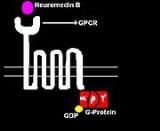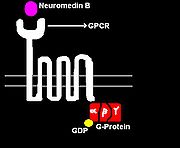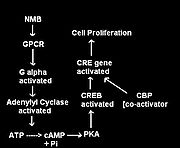
Neuromedin B
Encyclopedia
Neuromedin B is a bombesin
-related peptide
in mammals. It was originally purified from pig spinal cord, and later shown to be present in human central nervous system
and gastrointestinal tract
.

 Neuromedin regulates the following functions:
Neuromedin regulates the following functions:
(NMBR). This receptor is a G protein-coupled receptor
with seven transmembrane spanning regions, hence the receptor is also denoted as a 7-transmembrane receptor (7-TMR). Upon binding several intracellular signaling pathways are triggered (see Figure 2).
When NMB binds to its 7-TMR, the heterotrimeric G protein
that is attached to the receptor is activated. The G-protein is called heterotrimeric because it consists of 3 polypeptides: α subunit, β subunit, and γ subunit. In the activated NMBR/G-protein complex, there occurs an exchange of GTP
for GDP
bound to G-α subunit. The G-α subunit, in turn, dissociated form the G-βγ subunits. The free G-α iactivates adenylate cyclase
(AC), which, in turn, catalyzes the conversion of ATP to cAMP, the latter of which functioning as a second messenger. cAMP activates of the enzyme Protein Kinase A (PKA). PKA enters the nucleus and activates the cAMP response element-binding
protein. The activated CREB binds along with CREB binding protein
, co-activator to the CRE region of the DNA in the nucleus. CREB and CBP are held together by leucine zipper
s. CRE is the control that activates number of growth factors, and thus cell proliferation and some anti-apoptotic genes. In the brain, CREB plays a role in long-term memory and learning.
Bombesin
Bombesin is a 14-amino acid peptide originally isolated from the skin of a frog. It has two known homologs in mammals called neuromedin B and gastrin-releasing peptide. It stimulates gastrin release from G cells. It activates three different G-protein-coupled receptors known as BBR1, -2, and -3. It...
-related peptide
Peptide
Peptides are short polymers of amino acid monomers linked by peptide bonds. They are distinguished from proteins on the basis of size, typically containing less than 50 monomer units. The shortest peptides are dipeptides, consisting of two amino acids joined by a single peptide bond...
in mammals. It was originally purified from pig spinal cord, and later shown to be present in human central nervous system
Central nervous system
The central nervous system is the part of the nervous system that integrates the information that it receives from, and coordinates the activity of, all parts of the bodies of bilaterian animals—that is, all multicellular animals except sponges and radially symmetric animals such as jellyfish...
and gastrointestinal tract
Gastrointestinal tract
The human gastrointestinal tract refers to the stomach and intestine, and sometimes to all the structures from the mouth to the anus. ....
.
Sequence
The sequence of the C-terminal decapeptide is highly conserved across mammalian species: GNLWATGHFM-(NH2); this decapeptide is sometimes noted as neuromein B, but it is more accurately described as neuromedin B 23-32. The sequence of neuromedin B (in rat) is : TPFSWDLPEPRSRASKIRVHPRGNLWATGHFM-(NH2).Function


- exocrineExocrine glandExocrine glands are a type of ductal glands that secrete their products into ducts that lead directly into the external environment...
and endocrineEndocrine systemIn physiology, the endocrine system is a system of glands, each of which secretes a type of hormone directly into the bloodstream to regulate the body. The endocrine system is in contrast to the exocrine system, which secretes its chemicals using ducts. It derives from the Greek words "endo"...
secretions - cell growth
- body temperature
- blood pressure and glucose level
Neuromedin signaling pathway
NMB acts by binding to its high affinity cell surface receptor, neuromedin B receptorNeuromedin B receptor
The neuromedin B receptor , now known as BB1 is a G protein-coupled receptor whose endogenous ligand is neuromedin B ....
(NMBR). This receptor is a G protein-coupled receptor
G protein-coupled receptor
G protein-coupled receptors , also known as seven-transmembrane domain receptors, 7TM receptors, heptahelical receptors, serpentine receptor, and G protein-linked receptors , comprise a large protein family of transmembrane receptors that sense molecules outside the cell and activate inside signal...
with seven transmembrane spanning regions, hence the receptor is also denoted as a 7-transmembrane receptor (7-TMR). Upon binding several intracellular signaling pathways are triggered (see Figure 2).
When NMB binds to its 7-TMR, the heterotrimeric G protein
Heterotrimeric G protein
"G protein" usually refers to the membrane-associated heterotrimeric G proteins, sometimes referred to as the "large" G proteins. These proteins are activated by G protein-coupled receptors and are made up of alpha , beta and gamma subunits, the latter two referred to as the beta-gamma...
that is attached to the receptor is activated. The G-protein is called heterotrimeric because it consists of 3 polypeptides: α subunit, β subunit, and γ subunit. In the activated NMBR/G-protein complex, there occurs an exchange of GTP
Guanosine triphosphate
Guanosine-5'-triphosphate is a purine nucleoside triphosphate. It can act as a substrate for the synthesis of RNA during the transcription process...
for GDP
Guanosine diphosphate
Guanosine diphosphate, abbreviated GDP, is a nucleoside diphosphate. It is an ester of pyrophosphoric acid with the nucleoside guanosine. GDP consists of the pyrophosphate group, the pentose sugar ribose, and the nucleobase guanine....
bound to G-α subunit. The G-α subunit, in turn, dissociated form the G-βγ subunits. The free G-α iactivates adenylate cyclase
Adenylate cyclase
Adenylate cyclase is part of the G protein signalling cascade, which transmits chemical signals from outside the cell across the membrane to the inside of the cell ....
(AC), which, in turn, catalyzes the conversion of ATP to cAMP, the latter of which functioning as a second messenger. cAMP activates of the enzyme Protein Kinase A (PKA). PKA enters the nucleus and activates the cAMP response element-binding
CREB
CREB is a cellular transcription factor. It binds to certain DNA sequences called cAMP response elements , thereby increasing or decreasing the transcription of the downstream genes....
protein. The activated CREB binds along with CREB binding protein
CREB binding protein
CREB-binding protein, also known as CREBBP or CBP, is a protein that in humans is encoded by the CREBBP gene.The CREB protein carries out its function by activating transcription, where interaction with transcription factors is managed by one or more of p300 domains: the nuclear receptor...
, co-activator to the CRE region of the DNA in the nucleus. CREB and CBP are held together by leucine zipper
Leucine zipper
A leucine zipper, aka leucine scissors, is a common three-dimensional structural motif in proteins. These motifs are usually found as part of a DNA-binding domain in various transcription factors, and are therefore involved in regulating gene expression...
s. CRE is the control that activates number of growth factors, and thus cell proliferation and some anti-apoptotic genes. In the brain, CREB plays a role in long-term memory and learning.

